Design Elements used in Truncale Guitars
Strait String Pull, Open Headstock
Strait string pull is used to reduce friction between the string and the nut, thereby giving the player a softer feel for the same string tension as well as better tuning performance and stability, even when bending notes. The implementation as an open headstock design is a Truncale original.
Wingless Bridge
I developed this concept of the wingless bridge after reading the works of Trevor Gore and Jurgan Myers. The system, created with this bridge and the interlocking radial bracing, allows easy tuning of top longitudinal stiffness to cross grain stiffness tailored to the unique characteristics of the individual top. This system has less of a tendency to fold the top in half, eliminating the high stress points that lead to large dimples and cracking around conventional bridge wings. Some evidence also supports the idea that the wingless bridge is more conducive to the long T(3,2) and cross tripole T(3,1) resonances that so many experienced luthiers find highly coveted yet incredibly elusive.
Interlocking Radial Bracing
Soundport
This contemporary feature brings a measure of intimacy to the players experience. It also is a great tool in micro tuning air resonance when modal tuning.
Bent and Laminated Linings
This feature adds impedance and rigidity to the guitar’s sides, thereby reflecting more of the top’s limited energy back into the system. This maximizes the existing volume, detail and sustain instead of it defusing into the sides.
tapered heel flush to cutout
Personally, I love the look of a traditional tapered heel and nothing is more elegant than for it to flow smoothly into the cutout.
armrest
The removable, magnetically attached armrest not only provides a comfortable rest for your arm but also keeps your arm from touching the vibrating top plate, providing a noticeable increase in sustain. It also protects the French polished shellack finish from your sweaty arm during those hot summer performances.









